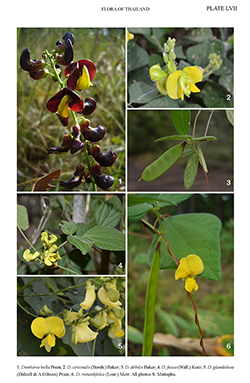e-Flora of Thailand
Volume 4 > Part 3.3 > Year 2023 > Page 552 > Leguminosae-Papilionoideae > Dunbaria
1. Dunbaria bella Prainwfo-0000203828
J. Asiat. Soc. Bengal, Pt. 2, Nat. Hist. 66(2): 434. 1897; Maesen, Agric. Univ. Wageningen Pap. 98(1): 17, f. 1. 1998. Plate LVII: 1.
Accepted Name : This is currently accepted.
Synonyms & Citations :
Description : Climber; young twigs hairy. Stipules caducous. Leaves: petioles 1.5–3 cm long, grooved, hairy; rachis 5–10 mm long, grooved, hairy. Leaflets: petiolules 2.5–3 mm long, hairy; blade elliptic to lanceolate, 9–11 by 2–3 cm, coriaceous, apex acute, base rounded, margin entire, upper surface hairy, lower surface hairy and glandular; veins raised below; stipels setaceous, ca 1 mm long. Pseudoracemes axillary, 15–25(–40) cm long, many-flowered, with 2 flowers per node; bracts triangular, ca 4 by 2 mm, caducous; pedicels 5–6 mm long. Calyx: tube, 5–7 by ca 2 mm, outside hairy and glandular, inside glabrous, without multicellular bulbous-based hairs; lobes lanceolate 2–4 by ca 2 mm, margin hairy; upper 2-lobed, connate, slightly separate at tip; lower 3-lobed, middle one longest, ca 10 mm long. Corolla: standard dark purple to reddish with faint veins, orbicular, 14–15 by 14–15 mm, basal callosities present, apex retuse, base auriculate 1 mm long, margin inflexed, both sides glabrous, claw 3–4 mm; wings oblong to obovate, 8–9 by 3–4 mm, apex obtuse, base auriculate ca 2 mm long, margin undulate, both sides glabrous, yellow to orange, claw 3.5–4 mm; keel, falcate, 10–12 by 5–6.5 mm, apex obtuse, margin entire, both sides glabrous, strongly curved. Stamens: staminal tube 15–20 mm long; filaments 6–8 mm long; anthers basidorsifixed. Ovary densely hairy and glandular; style 18–19 mm long, hairy at base. Pods laterally compressed, 8–10 by 0.7–0.8 cm, pubescent. Seeds 7–8, globose, 5–5.5 mm in diameter.
Thailand : NORTHERN: Mae Hong Son (Mae Sariang), Chiang Mai (Doi Chiang Dao NP, Doi Inthanon NP, Doi Sa Ket; Doi Suthep – type of Dunbaria longeracemosa: Kerr 917, lectotype -K, designated by van der Maesen 1998, isolectotypes -BM TCD; Fang, Hot, Mae Chaem, Mae Rim, Op Luang), Chiang Rai (Khun Chae, Doi Luang), Lamphun (Doi Khun Tan NP, Mae Li), Lampang (Chae Son NP, Mae Tha), Tak (Doi Son, Mae Sot, Sam Ngao, Umphang), Sukhothai (Kirimat), Phitsanulok (Kaeng Sopha Waterfall, Thung Salaeng Luang NP), Nakhon Sawan (Ban Ta Khli, Phayuha Khiri); NORTH-EASTERN: Phetchabun (Nam Nao NP), Loei (Phu Kradueng NP, Phu Ruea NP, Na Haeo, Wang Saphung), Udon Thani, Sakon Nakhon (Phu Phan NP), Nakhon Phanom, Mukdahan (Phu Pha Thoep NP, Phu Sa Dok Bua NP); EASTERN: Chaiyaphum (Phu Khiao WS, Phu Lanka) Surin, Ubon Ratchathani (Khong Chiam), Nakhon Ratchasima (Bua Yai, Sakaerat); SOUTH-WESTERN: Kanchanaburi (Sai Yok, Sisawat, Thong Pha Phum), Phetchaburi (Bo Fai), Prachuap Khiri Khan (Hua Hin); SOUTH-EASTERN: Sa Kaeo (Ta Praya), Chon Buri (between Makham and Khao Klu), Chanthaburi (Ban Ta Mun); PENINSULAR: Chumphon (Ko Maprao, Pa Thio), Trang (Thung Khai Botanical Garden).
Distribution : Myanmar (type), Laos, Cambodia, Vietnam.
Ecology : Dry deciduous and oak-pine forests, frequently in open, disturbed deciduous forest, sometimes in open sandy scrub forests near beaches; 0–1,600 m alt. Flowering and fruiting: October–January.
Vernacular : Khang khrang (ขางครั่ง)(Lamphun); dok khrung (ดอกครั่ง), thao dok khua (ถั่วดอกคั้ว), thua khaeng kra duk (ถั่วแข้งกระดูก)(Northern); maha niao (มะหาเหนียว), paep pa (แปบป่า)(Eastern); nguang chang (งวงช้าง)(South-western); mai khem pa (ไม้เข็มป่า)(Southeastern).

